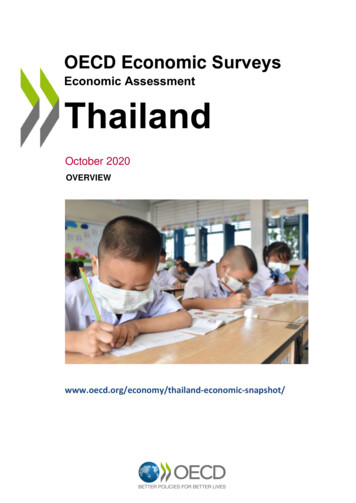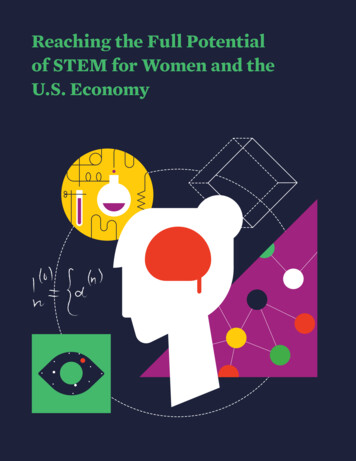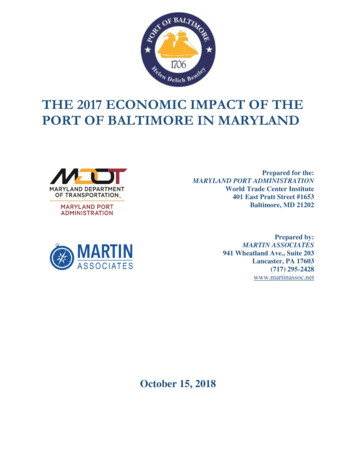
Transcription
2020EmergingJobs ReportThailand
AboutThe ReportOver two million people in Thailand have a LinkedIn profile. As this enormous living,breathing dataset evolves in real time, it creates powerful insights organisations can useas they plan the future of their workforce.LinkedIn has crunched its unique dataset to establish the fastest growing jobs in thetalent market. They’re not necessarily brand new roles though. An emerging job mayhave grown out of a more traditional job, or it may be a completely new job that hasbeen created to address business needs.While there may not yet be a large pool oftalent who hold this job, we have observed large, sustained year-over-year growth ofprofessionals who are hired into the role and believe these to be long-term trends.2
2020JobTrendsThailand’s online world is driving demand for digital marketers.According to 2019 research by We Are Social and Hootsuite’s Digital, Thais on averagespend five hours and 13 minutes per day on mobile internet, more than any other countryin the world.1 Coming eighth in the world for social media penetration, it seems muchof this time online is spent on various social platforms.2 It’s unsuprising that this country’se-commerce market, worth US 5 billion in 2019, is expected to more than triple toUS 18 billion in 2025, according to the e-Conomy SEA 2019 report by Google, Temasekand Bain & Company.3 The rich online world explains the preponderance of emergingdigital marketing roles as companies are keen to use the internet to get to their customers.Big data is supercharging Thailand 4.0.A two decade commitment by the government, known as Thailand 4.0, will see the country’seconomy shift from heavy industries to one driven by innovation, research and development.A key part of this plan is to introduce high-speed broadband across the country, to supportthe government’s data-driven efforts. It’s not just a way to improve service delivery, Thailandsees it as a way to improve productivity. Take its agriculture sector, which employs a third ofthe population, but only produces 10 percent of GDP. Business and government will use datato make more informed decisions.4 With plans to train more than 1,000 government officersin data in 2020, it’s clear this national focus on data is fuelling emerging jobs too - three ofThailand’s top six emerging jobs are data related.5The global skills gap is fuelling a fiercely competitive talent market.6As digital economies across Southeast Asia take off, it can be difficult to lure and keep indemand talent, particularly in niche or emerging roles. In 2019, some US 110 million hadbeen invested in Thai’s startups, compared with US 263 million in Vietnam and US 2.4 billionin Indonesia.7 This lower start-up funding has led to something of a brain drain in Thailand,as tech and other in-demand start-up talent chase funding.8 Emerging roles such as talentacquisition specialist and human resources business partner reflect this competitive talentmarket, as companies look to firm up their talent and find those hard-to-get niche skills.3
The top 10 emerging jobs
#1DataScientistThe modern data scientist is part computer scientist, part mathematician. The best onesare also excellent trend spotters. The rise of the data scientist has largely mirrored the rise ofbig data as a phenomenon. As organisations are delivered more and more data, they needdata scientists to help them generate meaningful and actionable insights.What you need to know:Data scientists mine insights from data in order to inform various business decisions acrosssales, operations, and strategy. They can be found across a wide range of industries.Banks are hiring data scientists for financial projections and fraud detection. Educationorganisations have data scientists researching learning trends and educational outcomes.Today, they are spreading across industries, with organisations like retailers now employingdata scientists to analyse client and market data.Top industries:Information Technology And Services, Banking, Telecommunications, Financial Services,Computer SoftwareSkills you need:Machine Learning, Deep Learning, Python (Programming Language), R, Apache SparkTop LinkedIn Learning courses:Python for Data Science Essential Training, Statistics Foundations: 1, Python: Data Analysis,Data Science Foundations: Fundamentals, Apache Spark Essential Training5
#2Back-endDeveloperEverything you don’t see and touch on a web application is the realm of the back-enddeveloper. The back-end developer is the person in charge of building and implementingwhat it is the web application is meant to do – the components that are indirectly usedthrough the shiny front-end.What you need to know:A good back-end developer will ensure that what the front end promises, the websitedelivers. Given the complexity of learning frameworks, back-end developers withextensive experience are typically in high demand. Back-end developers are usuallyexpected to maintain data and application program interfaces (APIs), as well as testand debug systems.Top industries:Information Technology And Services, Computer Software, Internet,Financial Services, TelecommunicationsSkills you need:Node.js, Docker Products, MongoDB, Go (Programming Language), MySQLTop LinkedIn Learning courses:PHP: Design Patterns, Advanced PHP, Python: Design Patterns, Learning Full-StackJavaScript Development: MongoDB, Node, and React, Learning Spring with Spring Boot6
#3DataEngineerWhat’s the difference between a data scientist and a data engineer? Well, like allengineers, data engineers are concerned with the ‘how to’ – so they are in charge of thingslike pipelines, data workflow management, and ETL (extract, transform, load) processes.While a data scientists focus more on the modeling and analysis of extracting insights,patterns and predictions from data.What you need to know:While a data scientist might be mining for insights, the data engineer is building the minefor those insights to be found. Insights are only as good as the database behind it, so a dataengineer is constantly building, testing, and maintaining the processing systems.Top industries:Information Technology & Services, Internet, Oil & Energy, Banking, Computer SoftwareSkills you need:Python (Programming Language), Hadoop, Apache Spark, Hive, ScalaTop LinkedIn Learning courses:Python for Data Science Essential Training, Apache Spark Essential Training, Data ScienceFoundations: Data Engineering, Learning Hadoop, Extending Hadoop for Data Science:Streaming, Spark, Storm, and Kafka,7
#4Full StackEngineerFull stack engineer is a combination of front-end web development and softwaredevelopment skills. Their versatility means they can run a project from start to finish andare in hot demand across a huge swathe of industries looking to add tech capacity asefficiently as possible.What you need to know:Known as the swiss army knife of tech roles, full stack engineers remain in incredibly hotdemand. Developing the breadth of skills necessary to be recognised as a full stackengineer is demanding, but those who can honestly claim competency across the fullsuite are likely to find themselves batting off great job offers regularly.Top industries:Information Technology & Services, Computer Software, Internet, Financial Services,Marketing & AdvertisingSkills you need:React.js, Node.js, MongoDB, JavaScript, MySQLTop LinkedIn Learning courses:Learning Full-Stack JavaScript Development: MongoDB, Node, and React, LearningSpring with Spring Boot, PHP: Design Patterns, C# Design Patterns: Part 1, Learning Redux8
#5ProductOwnerSitting atop the scrum development team is the product owner, the leader responsiblefor the value of the products created. A product owner is yet another hybrid-style emergingjob, combining roles like market analyst, project management, product designer, andbusiness strategist.What you need to know:Using their blend of soft and hard skills, a product owner oversees every stage of aproject’s development. This emerging job reflects the rise of agile culture, which focuses oncollaboration and allowing for evolving needs, rather than prescriptive approaches to tasks.Top industries:Internet, Information Technology & Services, Banking, Computer Software,Financial ServicesSkills you need:Agile Methodologies, Product Management, Agile Project Management, Scrum,Product Development,Business AnalysisTop LinkedIn Learning courses:Agile Product Owner Role: Techniques, Agile Product Owner Role: Foundations,Scrum: The Basics, Agile at Work: Planning with Agile User Stories, Product ManagementFirst Steps9
#6DataAnalystDrilling down into raw data and finding insights is the role of the data analyst. Like a datascientist, a data analyst will have maths and statistics skills, as well as be able to useprogramming languages but may not be as focused on modelling and forecasting as adata scientist.What you need to know:Collecting data is increasingly easier, but harnessing the data to deliver insights can bedifficult. Data analysts help businesses be competitive by delivering tangible businessinsights that can be readily implemented.Top industries:Information Technology & Services, Internet, Marketing & Advertising, Financial Services,BankingSkills you need:Tableau, SQL, R, Microsoft Power BI, Python (Programming Language)Top LinkedIn Learning courses:Python for Data Science Essential Training, SQL: Data Reporting and Analysis, Tableau 10Essential Training, Statistics Foundations: 1, Python: Data Analysis10
#7User ExperienceDesigner“How can I make the user’s experience better?” This is the fundamental question that drivesuser experience designers - whether they are improving an app, developing a website, ormaking products easier for use. The user experience designer role requires talent with ahybrid of soft skills such as analysis, collaboration and prioritisation, and hard skills such ascoding and prototyping.What you need to know:The overwhelming majority of experience designers have traditionally been found in techcompanies, where they improve apps and websites. However, they are now spreading outacross all industries.Top industries:Information Technology & Services, Internet, Design, Computer Software, BankingSkills you need:User Interface Design, User Experience (UX), Wireframing, Sketch App, Web DesignTop LinkedIn Learning courses:UX Foundations: Research, Design Thinking: Understanding the Process, UX Design: 2Analyzing User Data, UX Design: 1 Overview, Planning a Career in User Experience11
#8TalentAcquisitionSpecialistSpecialising in filling niche roles or finding hard-to-get skills in competitive markets, the talentacquisition specialist is an expert in sourcing new employees. With the ability to map talentand plot out the life cycle of roles, they help find talent with the right skills and the rightculture fit.What you need to know:Collaboration is a key skill for talent acquisition specialists. Through consultation with hiringmanagers and even perhaps executives, they can proactively create talent pipelines foremerging roles and build a talent pool to continuously tap. They need not only to understandthe demands of the organisation, but also present an attractive employer brand to potentialrecruits. With Thailand’s competitive talent market, it’s clear why these roles are in demand.Top industries:Information Technology & Services, Banking, Internet, Retail, Consumer GoodsSkills you need:Recruiting, Sourcing, Talent Management, Human Resources (HR), Technical RecruitingTop LinkedIn Learning courses:Talent Sourcing, Technical Recruiting, Recruiting Foundations, Interviewing a JobCandidate for Recruiters, Niche Recruiting12
#9Digital MarketingSpecialistA digital marketing specialist is swiftly becoming a non-negotiable element of the modernmarketing team. Their role may fall under a few different names, but they are someone whouses data to identify target markets and generate digital marketing campaigns. Althoughdigital marketing specialists may work across a range of areas, some specialise in searchengine optimisation (SEO), social media, or paid search (PPC).What you need to know:Tapping into the online world to boost sales and garner new customers, the digital specialistis the next generation of marketing, advertising and customer communications. Usingdigital products to track social media and online reach, the digital specialist helps plan,develop and execute digital strategies. They may have a particular expertise in certainareas, such as content marketing, social media marketing or pay-per-click.Top industries:Marketing & Advertising, Information Technology & Services, Internet, Hospitality,Real EstateSkills you need:Google Ads, Social Media Marketing, Facebook Marketing, Google Analytics,Search Engine Optimization (SEO)Top LinkedIn Learning courses:SEO: Keyword Strategy, Content Marketing Foundations, Social Media Marketing: ROI,Social Media Marketing for Small Business, Advertising on Facebook13
#10Front-endDeveloperThe front-end developer works with web designers to craft the visual elements of webapplications and ensure they work as they should. A front-end developer will typicallyselect, install, and test the user interface elements of a website.What you need to know:The front-end developer takes an active and crucial role in the development of new featuresand enhancements to applications used by consumers and businesses every day.Top industries:Information Technology & Services, Computer Software, Internet, Marketing & Advertising,Financial ServicesSkills you need:React.js, JavaScript, AngularJS, Cascading Style Sheets (CSS), jQueryTop LinkedIn Learning courses:Learning ECMAScript 6, Learning Redux, CSS: Animation, Learning Full-Stack JavaScriptDevelopment: MongoDB, Node, and React, TypeScript Essential Training14
EmergingJobsDefinitionWhat is an emerging job?We define an “emerging job” as a role that has seen tremendous growth within a region.This means, while there may not be a large pool of talent who hold this job, we haveobserved large, sustained year-over-year growth of professoonals who are hired into therole and believe these to be long-term trends.Why do we publish the Emerging Jobs list?Often these roles are indicative of larger industry trends, or represent societal shifts thatare increasing demand for a role.These insights are meant to: Help job seekers understand the types of jobs and skills that will be making up thejobs of the future. Guide employers to help them find talent, and identify areas to invest in. Highlight societal and indurstry trends and the impact of these trends on theglobal workforce.
MethodologyEmerging JobsThe Emerging Jobs analysis is done on all LinkedIn members with a public profile thathave held a full-time position within Thailand during the past five years. Once the talentpool has been identified, we then calculate the share of hiring and Compound AnnualGrowth rate of this proportion for each occupation between 2015 and 2019 to identifythe roles with the largest growth. These become our Emerging Jobs.
ClosingNoteAre other organisations navigating the same disruption to their talent as you? Has therest of the market already identified and begun addressing their skills gap? Do you havethe building blocks in your organisation to fill your future needs or will you have to gosearching in the talent market?This report is a useful example of the insights possible when you delve into LinkedIn’sunparalleled dataset. Of course, opportunities exist to go deeper and get morecustomised. In particular, LinkedIn Talent Insights can equip HR make data-drivendecisions, while LinkedIn Learning Skills Insights allow you to benchmark and identifyrising skills that existing talent needs.It’s not just organisations that can benefit, however.Just as it’s important for companies to contextualise themselves - it is of enormousvalue to individuals too. The benefits of this approach extend beyond simply identifyingwhat jobs are now in high demand. It’s also about identifying the skills that have led tothese jobs breaking from the pack and assessing where there might be overlaps withindividual experience and potential.For those serious about rising, LinkedIn Learning courses are among a number of onlineresources available for those who want to keep their skills up to date.
About LinkedIn’s Economic GraphThe Economic Graph is a digital representation of the global economy based on675million members36thousand skills50million companies20million open jobs90thousand schoolsIn short: it is all the data on LinkedIn.Through mapping every member, company, job, and school, we are able tospot trends like talent migration, hiring rates, and in-demand skills by region.These insights help us connect people to economic opportunity in new ways.And by partnering with governments and organisations around the world,we help them better connect people to opportunities.18
19
References1We Are Social Page 3 Source2We Are Social Page 3 Source3Temasek Page 3 Source4Tech in Asia Page 3 Source5Tech Wire Asia Page 3 Source6LinkedIn Page 3 Source7Temasek Page 3 Source8Bangkok Post Page 3 Source20
Node.js, Docker Products, MongoDB, Go (Programming Language), MySQL Top LinkedIn Learning courses: PHP: Design Patterns, Advanced PHP, Python: Design Patterns, Learning Full-Stack . Learning Full-Stack JavaScript Development: MongoDB, Node, and React, Learning Spring with Spring Boot #2 6. Data Engineer What's the difference between a data .










